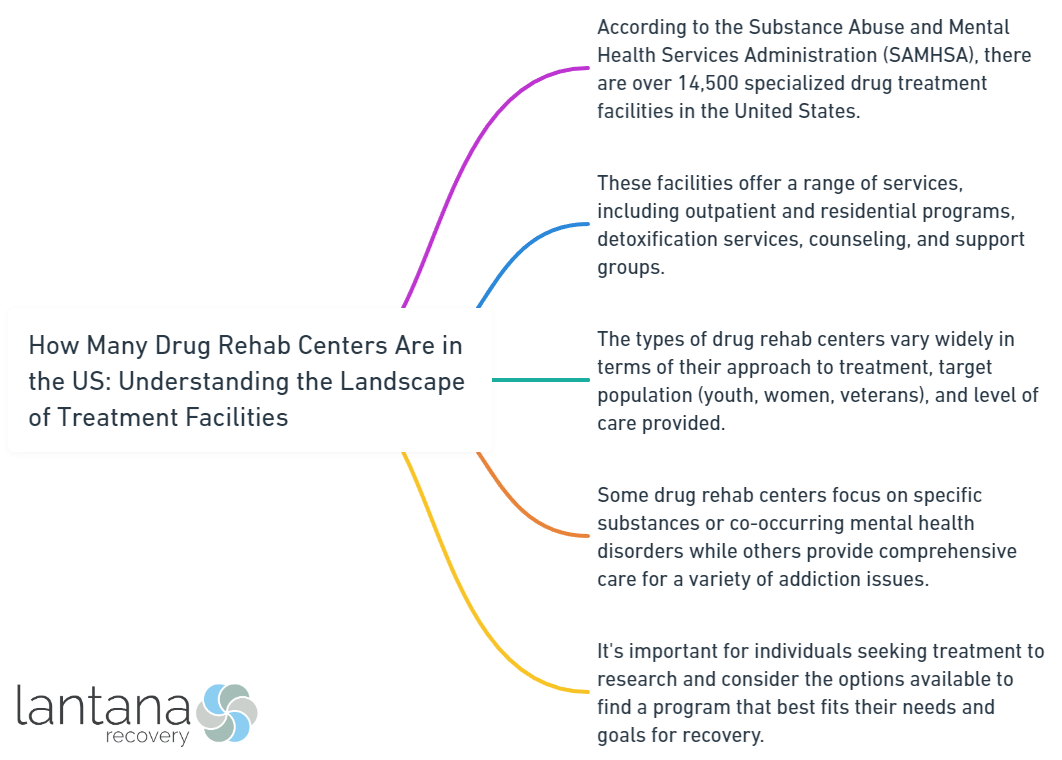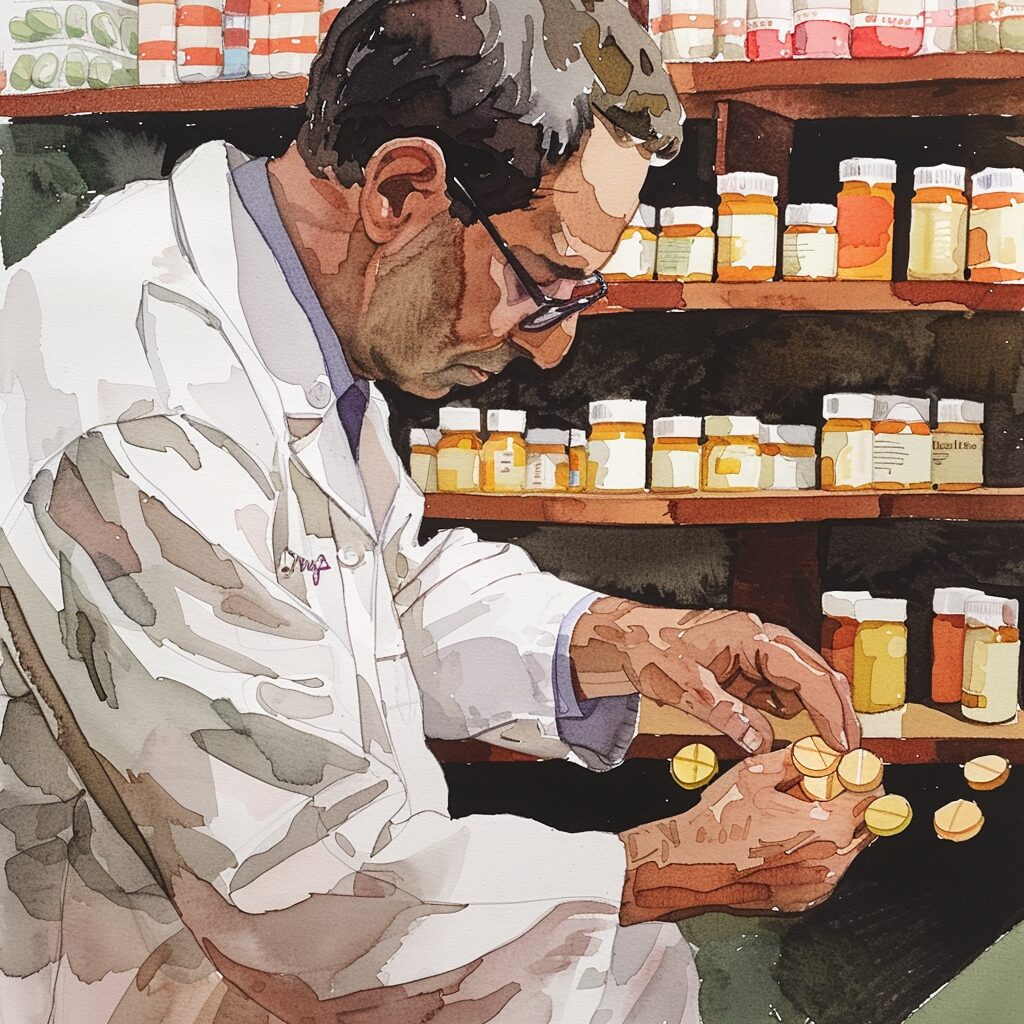Drug addiction is a complex issue that affects individuals and communities across the United States. Drug rehab centers play a crucial role in providing treatment and support to those struggling with substance abuse disorders. Understanding the landscape of drug rehab centers in the US is essential for individuals seeking help and for policymakers looking to address the addiction crisis effectively.
Drug rehab centers serve a vital purpose in helping individuals overcome drug addiction and achieve long-term recovery. They provide a structured and supportive environment where individuals can receive evidence-based treatment, counseling, and therapy to address the physical, emotional, and psychological aspects of addiction.
To understand the landscape of drug rehab centers in the US, it is important to consider factors such as the number of facilities, regulations, and types of treatment approaches available. Currently, there is a range of drug rehab centers throughout the country, including residential, outpatient, and intensive outpatient facilities. These centers are regulated by state and federal laws, ensuring they meet certain standards of care and safety.
The exact number of drug rehab centers in the US can vary, as new facilities may open while others may close or change ownership. However, according to the Substance Abuse and Mental Health Services Administration (SAMHSA), in 2019, there were over 14,600 specialized drug treatment centers in the US. These centers provide a wide range of services to meet the diverse needs of individuals seeking recovery.
When choosing a drug rehab center, it is important to consider various factors. Location and accessibility, treatment approaches and modalities, accreditation and licensing, as well as cost and insurance coverage are all crucial considerations. By taking these factors into account, individuals can find a drug rehab center that aligns with their specific needs and preferences.
Common services and programs offered by drug rehab centers include detoxification services, inpatient rehabilitation programs, outpatient rehabilitation programs, as well as sober living and aftercare support. These comprehensive treatment options aim to address the physical, psychological, and social aspects of addiction in a holistic and individualized manner.
However, it’s important to recognize that drug rehab centers also face challenges and limitations. Availability and wait times for treatment, insurance coverage and affordability, staffing and quality of care, as well as relapse rates and long-term success, are all factors that can impact the effectiveness of these facilities. Ongoing efforts are being made to improve access to quality care and address these challenges within the drug rehab center landscape.

The Importance of Drug Rehab Centers
The Importance of Drug Rehab Centers cannot be overstated in addressing substance abuse and addiction in the United States. They provide professional support, a safe and supportive environment, structured treatment programs, access to medical care, peer support, and long-term support. It is crucial to find a rehab center that aligns with an individual’s specific needs, preferences, and recovery goals. Seeking help is the first step towards recovery, and rehab centers play a vital role in supporting individuals on their path to a healthier and substance-free life.
What Is the Purpose of Drug Rehab Centers?
The purpose of drug rehab centers is to provide effective treatment and support for individuals struggling with substance abuse and addiction. Drug rehab centers are focused on encouraging recovery and helping individuals overcome addiction in order to achieve long-term recovery.
These centers create a safe and supportive environment where individuals can solely focus on their recovery journey without any triggers or temptations present. By doing so, rehab centers promote healing and encourage the development of healthier habits and coping mechanisms.
Additionally, they offer comprehensive treatment programs that are tailored to meet the specific needs of each individual. These programs may include detoxification services, inpatient rehabilitation programs, outpatient rehabilitation programs, and aftercare support services.
Therapy and counseling services are also provided by rehab centers to address the underlying causes of addiction and assist individuals in developing strategies for managing cravings, stress, and triggers.
Furthermore, these centers recognize that addiction affects all aspects of an individual’s well-being, including their physical, mental, emotional, and social health. To support holistic well-being, drug rehab centers incorporate various therapies and activities such as exercise, art therapy, mindfulness practices, and life skills training.
Overall, the purpose of drug rehab centers is to provide comprehensive and holistic treatment to help individuals overcome addiction and achieve a healthier and more fulfilling life.
Understanding the Landscape of Drug Rehab Centers in the US
Understanding the landscape of drug rehab centers in the US is crucial for individuals seeking substance abuse treatment. When choosing a facility, there are several key factors to consider. First and foremost is availability. The US has a multitude of drug rehab centers, with recent data showing thousands of facilities across the country.
Secondly, it’s important to evaluate the types of treatment programs offered. Drug rehab centers provide a range of programs to cater to different needs, including residential treatment, outpatient programs, detoxification services, and aftercare support. Assessing your specific requirements is essential in selecting the right program for your recovery journey.
Moreover, treatment approaches can vary between rehab centers. Some focus on traditional 12-step programs, while others embrace holistic therapies, evidence-based practices, or a combination of different approaches. Understanding the treatment philosophy and approach of a center can help you find a program that aligns with your preferences.
Staff qualifications and expertise are also crucial considerations. Rehabilitation professionals such as doctors, therapists, and counselors should have appropriate credentials and experience in addiction treatment. Their expertise plays a vital role in ensuring effective care and support throughout your recovery process.
While not the most significant factor, facility amenities can contribute to your overall treatment experience. Some drug rehab centers provide fitness centers, recreational activities, or specialized treatment areas. These amenities can enhance your journey towards recovery.
Furthermore, understanding insurance coverage and payment options is important. It’s crucial to ensure that the rehab center accepts your insurance or offers affordable payment plans. This knowledge can help alleviate financial concerns while receiving the necessary treatment.
By considering these various aspects and conducting thorough research, individuals can make informed decisions when selecting a drug rehab center in the US. Understanding the landscape of drug rehab centers is essential in finding a facility that aligns with your needs, goals, and preferences on the path to recovery.
How Many Drug Rehab Centers Are There in the US?
There are a multitude of drug rehab centers in the US that cater to individuals struggling with substance abuse and addiction. These centers provide the necessary support and resources for achieving sobriety and maintaining long-term recovery. It is crucial to address the widespread issue of substance abuse in the US, which is why having thousands of drug rehab centers is so important. This way, individuals in need of help can access treatment options that suit their specific needs.
Different types of drug rehab centers, including detoxification services, inpatient rehabilitation programs, outpatient rehabilitation programs, and sober living facilities, are available to provide the most appropriate level of care for each situation. It is important to note that the quality and effectiveness of the centers can vary. Factors to consider include accreditation, licensing, treatment approaches, and modalities. Moreover, location, accessibility, cost, and insurance coverage should be taken into account by individuals seeking treatment.
What Types of Drug Rehab Centers Are There?
When it comes to drug rehab centers, individuals have various options to choose from. These centers are tailored to meet the needs of those struggling with addiction.
1. Residential Inpatient Centers: These facilities offer round-the-clock care and assistance in a structured environment. They provide therapy, counseling, and medical supervision.
2. Outpatient Treatment Centers: Outpatient centers enable individuals to receive treatment while residing at home. They offer flexibility in scheduling and provide therapies, support groups, and educational programs.
3. Luxury Rehab Centers: Luxury rehab centers provide an upscale experience with amenities like private rooms, gourmet meals, and spa services. These centers cater to individuals seeking a more comfortable and private treatment experience.
4. Holistic Rehabilitation Centers: Holistic centers focus on treating the whole person, addressing their mind, body, and spirit. Along with conventional approaches, they incorporate alternative therapies such as yoga, meditation, acupuncture, and nutrition counseling.
5. Dual Diagnosis Treatment Centers: These centers specialize in treating individuals who have co-occurring mental health disorders and addiction. They offer integrated treatment for both conditions simultaneously.
Each rehab center offers unique approaches and services, allowing individuals to select the one that best suits their needs. Factors such as the severity of addiction, personal preferences, and financial considerations should be taken into account when making a decision.
Remember that seeking help is a courageous step towards recovery. If you know someone struggling with addiction, reach out to a professional and explore the various types of drug rehab centers available to provide support and treatment.

Factors to Consider When Choosing a Drug Rehab Center
When it comes to choosing a drug rehab center, there are key factors that should not be overlooked. From the location and accessibility to the treatment approaches and accreditation, every aspect plays a crucial role in the recovery journey. And let’s not forget about the financial aspect – cost and insurance coverage can significantly impact the decision-making process. So, join me as we dive into these essential factors, exploring what to consider when choosing a drug rehab center in the United States.
Location and Accessibility
When choosing a drug rehab center, it is important to consider the location and accessibility. These factors play a significant role in finding the right facility for your needs.
Firstly, proximity is crucial. It is advisable to choose a center that is close to your home or the individual seeking treatment. Having a nearby facility makes it easier for family members to visit and provide support during the recovery process.
Secondly, transportation options should be taken into account. Look into the availability of transportation to and from the rehab center. Check if there are public transport services or specialized transportation services that can assist individuals in reaching the facility.
Confidentiality and privacy are also important considerations. Pay attention to the center’s policies on patient privacy and security. It is crucial to ensure that confidentiality is maintained throughout the treatment process.
Accessibility for individuals with disabilities is another vital factor to consider. Evaluate the facility’s accessibility for people with physical and sensory impairments. It is necessary to check if accommodations are provided to cater to the needs of individuals with disabilities.
Additionally, local support systems are worth considering. Look into the presence of support groups, sober living communities, and other resources near the rehab center. These support systems can greatly contribute to the recovery journey.
Environmental factors can also contribute to the overall atmosphere of recovery. Take into account the physical environment surrounding the facility. It is beneficial to choose a peaceful location that can enhance the conducive atmosphere for rehabilitation.
Lastly, it is crucial to check if the facility accepts your insurance plan and the extent of coverage it provides for the treatment costs. Insurance coverage plays a significant role in determining the feasibility of the rehab center.
By considering these factors, individuals can make an informed decision when choosing the right drug rehab center that meets their location and accessibility requirements.
Treatment Approaches and Modalities
When selecting a drug rehab center, it is important to consider the various treatment approaches and modalities they offer. These approaches and modalities play a vital role in the recovery process. It is crucial to take into account the following factors:
- Evidence-based therapies: It is beneficial to choose a rehab center that provides cognitive-behavioral therapy (CBT), dialectical behavior therapy (DBT), and motivational interviewing. These therapies have been proven effective in treating substance use disorders.
- Individualized treatment plans: Look for a rehab center that customizes the treatment approach to meet the specific needs and goals of each individual.
- Holistic approaches: Some rehab centers offer additional therapies such as yoga, meditation, art therapy, and equine therapy. These holistic approaches can enhance well-being and contribute to the healing process.
- Continuum of care: It is advisable to choose a rehab center that not only offers initial treatment but also provides aftercare support and relapse prevention programs for long-term sobriety.
- Peer support: Seek out a rehab center that offers support groups or group therapy sessions, enabling individuals to connect with others who are on a similar journey.
Taking these treatment approaches and modalities into consideration will assist you in selecting a drug rehab center that aligns with your specific needs and goals. This, in turn, will increase your chances of achieving successful recovery.
Accreditation and Licensing
Accreditation and licensing play a crucial role in the selection of a drug rehab center. These factors ensure that the facility adheres to specific quality and safety standards.
First and foremost, the accreditation process signifies that the center has undergone a thorough evaluation conducted by an independent accrediting body. This evaluation confirms that the center meets the criteria for program effectiveness, facility safety, and staff qualifications. The presence of accreditation assures potential clients and their families that they will receive high-quality care.
In addition to accreditation, licensing is a necessary legal requirement. It serves as verification that the center meets the minimum standards set by regulatory agencies. This includes adherence to safety regulations, staff qualifications, and treatment protocols. By obtaining licensing, the drug rehab center demonstrates its commitment to legal operations.
When determining which drug rehab center to choose, it is essential to ensure that it holds both accreditation and licensing. Information regarding these credentials can typically be found on the center’s website or by reaching out to admissions. By doing so, individuals can protect themselves from fraudulent or unqualified treatment providers.
To further emphasize the significance of accreditation and licensing, let’s examine a real-life scenario. Lisa found a drug rehab center for her brother but discovered that it lacked accreditation and licensing despite claiming to provide comprehensive treatment. As a result, she opted for a different facility that possessed the proper credentials, ultimately leading to her brother’s successful recovery. This story highlights the importance of considering accreditation and licensing when making decisions about drug rehab centers.
Cost and Insurance Coverage
Consider the cost and insurance coverage when choosing a drug rehab center. These factors greatly impact treatment affordability and financial responsibility.
| Factors to Consider | Cost and Insurance Coverage |
| 1. Treatment duration | The cost of rehab programs varies based on treatment length. Longer programs may have higher costs. |
| 2. Inpatient vs. outpatient | Inpatient programs, where individuals reside at the facility, are more expensive than outpatient programs where individuals receive treatment during the day and return home. |
| 3. Treatment amenities | Facilities offering luxury amenities or specialized services may have higher costs compared to more basic treatment centers. |
| 4. Insurance coverage | The extent of insurance coverage can vary. Understand what services are covered and any out-of-pocket expenses. |
| 5. Payment options | Some rehab centers offer payment plans or sliding scale fees based on income, making treatment more affordable for individuals with limited financial resources. |
Inquire about cost and insurance coverage during the initial assessment or intake process at a drug rehab center. This ensures a clear understanding of the financial commitments and enables proper planning. Contact insurance providers directly to verify coverage and determine any restrictions or treatment requirements.

Common Services and Programs Offered by Drug Rehab Centers
Get to know the variety of services and programs available at drug rehab centers in the US. From detoxification services to inpatient and outpatient rehabilitation programs, as well as sober living and aftercare support, these facilities offer a range of options to help individuals on their journey to recovery. Discover the diverse landscape of treatments and resources provided by drug rehab centers.
Detoxification Services
When seeking help for drug addiction, detoxification services play a crucial role in facilitating the recovery process. These specialized services focus on safely removing harmful substances from the body and effectively managing withdrawal symptoms. Detoxification services encompass a range of key aspects that are essential for successful treatment:
-
Medical supervision: The detoxification process should always be overseen by qualified medical professionals who carefully monitor vital signs, administer necessary medications, and prioritize the overall safety and comfort of the individual.
-
Individualized treatment plans: Each person’s unique needs and circumstances are thoroughly assessed in order to develop a personalized treatment approach. This ensures that any required medical interventions can be effectively incorporated into the detoxification plan.
-
Clinically managed withdrawal: Gradually reducing drug use or employing medication-assisted treatment techniques significantly minimizes the intensity of withdrawal symptoms, allowing for a safer and more comfortable discontinuation of substance use.
-
Emotional support: Recognizing the profound emotional challenges that arise during detox, it is crucial for detoxification services to offer counseling, therapy, and support groups. This comprehensive approach helps individuals navigate and address the complex emotions associated with their recovery journey.
-
Transition to further treatment: After the completion of detoxification, it is vital that individuals have access to a comprehensive treatment program that addresses addiction-related issues and provides ongoing support to promote long-term sobriety.
Detoxification services play a pivotal role in laying the foundation for a successful recovery from drug addiction. By prioritizing medical supervision, offering individualized treatment plans, implementing clinically managed withdrawal methods, providing emotional support, and facilitating a seamless transition to further treatment, individuals can receive the necessary care and support to embark upon their recovery journey.
Inpatient Rehabilitation Programs
Inpatient rehabilitation programs offer intensive care and support for drug addiction in a structured environment. Here are key factors to consider:
- 24/7 Supervision: Inpatient programs provide round-the-clock monitoring and support to ensure safety and prevent relapse.
- Medical Detoxification: Inpatient programs often include medically supervised detoxification to help patients safely manage withdrawal symptoms.
- Multidisciplinary Approach: Inpatient programs have a comprehensive treatment team consisting of doctors, nurses, therapists, and support staff to address all aspects of addiction.
- Therapeutic Interventions: Inpatient programs offer evidence-based therapies like individual counseling, group therapy, cognitive-behavioral therapy, and holistic approaches to address the psychological and emotional aspects of addiction.
- Structured Routine: Inpatient programs have a daily schedule focusing on therapy sessions, educational workshops, recreational activities, and healthy routines to instill discipline and aid in recovery.
- Peer Support: Inpatient programs provide opportunities for patients to connect with others going through similar experiences, fostering camaraderie and support.
- Aftercare Planning: Inpatient programs assist in developing a comprehensive aftercare plan to ensure a smooth transition to outpatient care, continued therapy, and ongoing support in the community.
Inpatient rehabilitation programs provide a highly immersive and focused treatment experience with a higher intensity of care and support than outpatient programs. They are recommended for individuals with severe addiction, co-occurring disorders, or those who require a more intensive treatment approach. Choosing an inpatient program that aligns with individual needs and preferences is crucial for successful recovery.
Outpatient Rehabilitation Programs
Outpatient rehabilitation programs are crucial for effectively addressing substance abuse and addiction. These programs provide vital treatment options for individuals who do not require round-the-clock supervision or residential care.
The benefits of outpatient rehabilitation programs are numerous:
-
Flexibility: These programs allow individuals to maintain their daily responsibilities while still receiving the necessary treatment. This aspect is especially valuable for those with demanding schedules or obligations.
-
Structured Support: Despite not being in a residential facility, outpatient programs still offer structure and support. Clients participate in therapy sessions, counseling, and other treatment interventions on a regular schedule. Such programs aid in establishing healthy routines and coping mechanisms.
-
Cost-Effectiveness: Outpatient treatment is generally more affordable than inpatient rehabilitation since it does not necessitate the same level of intensive, 24-hour care. It serves as a more accessible option for individuals facing financial constraints or having limited insurance coverage.
-
Continuum of Care: Outpatient programs often serve as the next phase of treatment after inpatient care, ensuring ongoing support and monitoring as individuals transition back to their daily lives. They facilitate a seamless transition and assist in maintaining long-term sobriety.
-
Community Integration: Outpatient programs allow individuals to remain connected with their local support networks, including friends, family, and recovery communities. This social support plays a crucial role in the recovery process and helps reduce feelings of isolation.
It is important to recognize that the effectiveness of outpatient rehabilitation programs can vary based on individual needs and the severity of addiction. Consulting with a medical professional or addiction specialist is vital in determining the most suitable level of care.
Sober Living and Aftercare Support
Sober living and aftercare support are essential components for individuals who have completed drug rehab programs. Once rehab is complete, individuals may transition to a sober living facility to continue their journey towards sobriety. These residential homes offer a nurturing and supportive environment where residents can apply the skills they acquired during rehab and smoothly reintegrate into their daily lives.
Adhering to a set of strict rules and guidelines, such as regular drug testing, attending support group meetings, and upholding work or educational commitments, fosters a sense of community and accountability among residents committed to sobriety. Moreover, ongoing counseling or therapy sessions are available to address any challenges encountered during the transition back into society.
Aftercare support extends beyond sober living homes and encompasses participation in meetings like Alcoholics Anonymous (AA) or Narcotics Anonymous (NA), individual counseling, or outpatient therapy. These support systems are pivotal in helping individuals maintain their sobriety and preventing relapse.
Sober living and aftercare support significantly contribute to the long-term success of individuals on their recovery journey. By providing a supportive environment, continual guidance, and access to resources, sober living and aftercare support enable individuals to develop their skills and overall well-being as they navigate life after rehab.

Challenges and Limitations of Drug Rehab Centers
Navigating the landscape of drug rehab centers in the US can be complex, with various challenges and limitations to consider. From availability and insurance coverage to staffing and relapse rates, this section sheds light on the key factors affecting the efficacy of these treatment facilities. Get ready to uncover the realities of wait times, affordability, quality of care, and the long-term success rates associated with drug rehab centers. Brace yourself for eye-opening insights into the limitations of these crucial establishments.
Availability and Wait Times
When considering a drug rehab center, it is crucial to consider availability and wait times. Factors to consider include:
1. Demand for drug rehab centers varies by location and time period. Some areas may have a higher demand for services, resulting in longer wait times for admission.
2. The availability of beds or spots in the rehab center can also affect wait times. Limited capacity can lead to longer wait times for individuals seeking treatment.
3. The desired treatment approach can also impact availability and wait times. Certain programs may be in higher demand, resulting in longer wait times for admission.
4. Insurance coverage and financial resources can impact availability. Limited options may be available based on insurance coverage or financial resources.
5. Urgency and severity of the individual’s situation should be considered when evaluating availability and wait times. If immediate intervention is necessary, exploring alternative options or seeking emergency services may be essential.
To ensure timely access to treatment, it is recommended to:
– Research and contact multiple rehab centers to inquire about availability and wait times.
– Consider alternative treatment options or locations if wait times are excessively long.
– Seek support from local organizations or healthcare professionals for resources or recommendations.
– Stay proactive and persistent in seeking treatment, as availability can change over time.
Insurance Coverage and Affordability
When selecting a drug rehab center, it is crucial to take into account insurance coverage and affordability. Below are some factors to consider:
- Review insurance coverage: Reach out to your insurance provider to gain an understanding of which treatment services are covered as well as any restrictions or limitations.
- Confirm in-network facilities: In-network rehab centers have established rates with your insurance company, resulting in lower out-of-pocket expenses. Ensure that the rehab center you opt for is in-network.
- Comprehend out-of-pocket expenses: Aside from insurance coverage, it is important to be aware of co-pays, deductibles, and other costs for which you may be responsible. Calculate these expenses to assess affordability.
- Explore options for financial assistance: Some rehab centers provide financial assistance programs or offering sliding scale fees based on income. Inquire about these alternatives if affordability is a concern.
- Consider alternative payment methods: If insurance coverage is limited or unavailable, explore other means of financing treatment, such as personal loans, crowd-funding, or healthcare credit cards.
Pro-tip: While affordability is significant, it is essential to prioritize the quality of care and the effectiveness of the treatment when making a final decision. Choose a rehab center that aligns with your needs and has a proven track record of aiding individuals in overcoming addiction. If necessary, directly contact the rehab center to discuss your financial situation and explore potential options or alternate arrangements.
Staffing and Quality of Care
When selecting a drug rehab center, it is important to consider staffing and the quality of care provided. These elements have a significant impact on the effectiveness and success of treatment. Here are some key points to remember:
- Qualified and Experienced Staff: It is crucial to ensure that the rehab center has highly trained and licensed professionals, including doctors, therapists, counselors, and nurses who specialize in addiction treatment. The staff should have expertise in treating various substance abuse disorders and use evidence-based treatment approaches.
- Staff-to-Patient Ratio: A low staff-to-patient ratio allows for personalized attention and care, ensuring that each patient receives the necessary support and guidance during their recovery.
- Continuity of Care: Quality rehab centers offer comprehensive treatment programs that include aftercare and relapse prevention. This helps individuals maintain their sobriety and reduces the risk of relapse.
- Reviews and Testimonials: Reading feedback from former patients and their families provides valuable insights into the quality of care provided by the rehab center. Positive feedback regarding the expertise of the staff indicates a commitment to providing high-quality care.
- Licensing and Accreditation: It is important to choose a rehab center that is licensed and accredited, as this ensures that it meets specific standards of care and undergoes rigorous evaluations for quality and safety.
By considering these factors, you can select a drug rehab center that prioritizes staffing and provides high-quality care for substance abuse treatment.
Relapse Rates and Long-Term Success
Relapse rates and long-term success are pivotal factors to consider when assessing drug rehab centers. Extensive research indicates that relapse rates vary based on individual circumstances and treatment methods. It is imperative to select a rehab center that has a proven track record of reducing relapse rates and promoting long-term success.
Several key elements contribute to lower relapse rates and better long-term outcomes, including:
- Personalized treatment plans: Tailored plans that address specific needs are essential for success.
- Comprehensive aftercare programs: Continuous support, such as sober living arrangements and counseling, minimizes the risk of relapse.
- Evidence-based approaches: Rehab centers that employ evidence-based therapies like cognitive-behavioral therapy (CBT) or dialectical behavior therapy (DBT) demonstrate improved long-term outcomes.
- Supportive community: Involvement of family and access to community resources enhance the prospects of maintaining sobriety.
- Continued monitoring and accountability: Regular check-ins and progress monitoring are significant in preventing relapse.
While it is impossible to guarantee long-term success and complete prevention of relapse, choosing a rehab center that prioritizes these factors significantly enhances the chances of successful recovery.
Frequently Asked Questions
Q: How many drug rehab centers are there in the US?
A: According to the 2018 National Directory of Drug and Alcohol Abuse Treatment Facilities, there are numerous drug rehab centers in the US. The directory provides a comprehensive listing of both government and private facilities across the country.
Q: How are the drug rehab centers organized in the directory?
A: The drug rehab centers in the directory are organized alphabetically by state, then by city within each state, and finally by facility name within each city. This makes it easy for individuals to locate and contact the appropriate facility based on their location.
Q: Does the directory include both government and private facilities?
A: Yes, the directory includes both government and private facilities that have been licensed, certified, or approved for inclusion by their respective State Substance Abuse Agencies. This ensures that individuals have access to a wide range of treatment options.
Q: How can I find a drug rehab center that offers services for hearing impaired or non-English speaking clients?
A: Each facility listing in the directory includes codes that indicate the services offered and other features of the facility. These codes also indicate if the facility provides services for hearing impaired and non-English speaking clients. A key explaining the codes is provided in the directory for easy reference.
Q: What is the significance of the $42 billion figure mentioned in the reference data?
A: The $42 billion figure refers to the estimated value of the drug and alcohol addiction rehab industry in the United States. This highlights the size and importance of the industry, which is projected to grow to $53 billion by 2025.
Q: Are there any challenges facing the addiction rehab industry?
A: Yes, the addiction rehab industry faces several challenges, including overbilling, patient brokering, and deceptive marketing by some treatment centers. These issues underline the need for reforms in the industry to ensure ethical practices and the well-being of patients.








